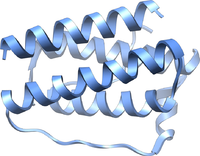
Photo from wikipedia
Introduction The specificity of cortisol after 1 mg dexamethasone (cortisolDST) ≥50 nmol/L as a criterion for mild autonomous cortisol secretion (MACS) is approximately 85% in patients with adrenal incidentalomas (AI).… Click to show full abstract
Introduction The specificity of cortisol after 1 mg dexamethasone (cortisolDST) ≥50 nmol/L as a criterion for mild autonomous cortisol secretion (MACS) is approximately 85% in patients with adrenal incidentalomas (AI). The aim was to study the associations of cortisolDST to age, BMI, and renal function. Methods We studied 1,129 patients with AI examined from 2005 to 2015 at Skåne University Hospital and Helsingborg Hospital. The covariates studied were gender, age, BMI, estimated glomerular filtration rate (eGFR), treatment with inhalation steroids, size of the AI, and size of the smallest AI in patients with bilateral AI (set to 0 in unilateral AI). We used machine learning models to uncover potential nonlinear associations. They were trained to fit the data and examined using feature importance analysis and partial dependence plots. Partial dependence plots show the marginal effect on cortisolDST of a covariate averaging over other covariates. Results CortisolDST was strongly associated with the size of the AI and weakly associated with age, BMI, and eGFR according to the feature importance analysis. The partial dependence plots indicated relatively linear relationships for cortisolDST to age (positively) and eGFR (negatively). The association between cortisolDST and BMI was nonlinear. At BMI below 30 kg/m2, cortisolDST was negatively associated with BMI, but it was unchanged at higher BMI levels. Using linear regression, we found that cortisolDST increased by 11% (95% CI, 7%–14%) for each 10-year increase in age. In patients with a BMI below 30 kg/m2, cortisolDST increased by 23% (95% CI, 16%–31%) for each 5 kg/m2 decrease in BMI. We found no association at BMI levels above 30 kg/m2. CortisolDST increased by 9% (95% CI, 6%–11%) for each 10 ml/min/1.73m2 decrease in eGFR. Conclusions CortisolDST is positively associated with age, negatively with BMI if below 30 kg/m2, and negatively with eGFR. These associations should be considered before diagnosing MACS.
Journal Title: Frontiers in Endocrinology
Year Published: 2022
Link to full text (if available)
Share on Social Media: Sign Up to like & get
recommendations!